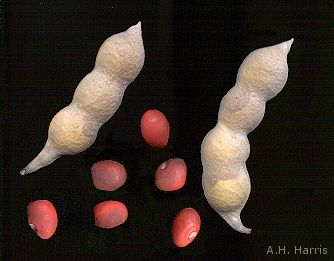
Humans entered the Southwest during the latter part of the last ice age. But the area then was not the desert of today—indeed, in the north, full desert vegetation apparently didn't arrive until about 4,000 years ago. Between the arrival and early historic times, human populations adjusted through the years to a continually changing mosaic of vegetation, losing familiar plants while others invaded. Yet, dependent primarily on wild plants for food until the introduction of agriculture from the south, local populations managed to identify which plants were edible, which plants were deadly, and which plants could be used to cure ills.
The process of deciphering which was which, had to be learned plant by
plant somewhere along the way. One can only wonder at the toll taken over the years by
the trial and error process. Someone had to be the first to try the mesquite bean (with
good results) and the berry of silver nightshade (with disastrous effects)—unsung
heroes who gave the desert people the varied diet that allowed life in this harsh
land.
![]()
Contributor: Arthur H. Harris, Laboratory for Environmental Biology, Centennial Museum, University of Texas at El Paso.
Desert Diary is a joint production of the Centennial Museum and KTEP National Public Radio at the University of Texas at El Paso.

Mescal beans and their pods (Sophora secundiflora), one of many Chihuahuan Desert natives believed to be poisonous. This plant also is known as Mountain Laurel. Scanned image by A.H. Harris.
Castetter, E. F. 1935. Uncultivated native plants used as sources of food. University of New Mexico Bulletin, Biological series 4 (1). Albuquerque.
West, S. 2000. Northern Chihuahuan Desert wildflowers. Facon Publishing, Inc., Helena. 222 pp.